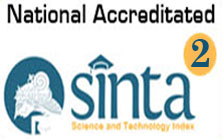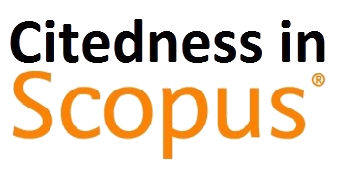The Influence of Providing Information and Educational Media in Efforts to Prevent Stroke
DOI:
https://doi.org/10.31965/infokes.Vol22.Iss2.1630Keywords:
Stroke, Prevention, Social Media, Educational Media, Public Awareness, IndonesiaAbstract
Stroke is the leading cause of physical and mental disability worldwide. In Indonesia, the incidence of stroke is alarmingly high, affecting approximately 10.9% of the population annually, with around 713,783 individuals experiencing stroke each year. Understanding how to prevent stroke is crucial. Clear and regular information, along with effective educational media, are essential for increasing public awareness of stroke. This study aims to determine the impact of social media and knowledge on stroke prevention. This type of study is a non-experimental quantitative study using a cross-sectional. This study is conducted in portions, with patients who are willing and able to talk effectively. Univariate, bivariate, and multivariate analyses were conducted using Pearson correlation tests and linear regression tests. The results show that among the 100 respondents, most were male, aged 41-60 years, and engaged in the best stroke prevention efforts. The Pearson correlation test showed significant correlations between information accuracy, frequency, and educational media for stroke prevention (Pearson p=0.89; p=0.62; p=0.75). The linear regression test revealed that the clarity of information, frequency of information, and educational media together increased stroke prevention efforts (p=0.037), with the clarity of information being the most significant factor. The conclusion is the study concludes that educational media and accurate information are crucial in preventing stroke. It is recommended that the Kasih Sayang Clinic conducts comprehensive stroke education and screening every six months to enhance prevention efforts.
Downloads
References
Aini, N., Mashfufa, E. W., Setyowati, L., Freeska, O., & Marta, D. (2022). The Effect of Education on Self-Management and Stroke Prevention Behavior on Recurrence. Jurnal Multidisiplin Madani (MUDIMA), 2(3), 1477–1488. Retrieved from https://journal.formosapublisher.org/index.php/mudima/article/view/251 DOI: https://doi.org/10.54259/mudima.v2i3.608
Ali, M., Berbudi Bl, A., Robbani, F. Y., Hanafi, I., Anugrah, M. R., Ansari, N. V., & Wijaya, S. P. (2023). Peningkatan Kesadaran Masyarakat Terhadap Pentingnya Pencegahan Dini Stroke. Jurnal Pengabdian Masyarakat Fisioterapi dan Kesehatan Indonesia, 2(01), 65-71. https://doi.org/10.59946/jpmfki.2023.199 DOI: https://doi.org/10.59946/jpmfki.2023.199
Azali, L. M. P., Sulistyawati, R. A., Saelan, S., & Putri, D. S. R. (2023). Edukasi Management Pengelolaan Faktor Penyebab sebagai Upaya Pencegahan Serangan Stroke dan Serangan Berulang. Jurnal Kreativitas Pengabdian Kepada Masyarakat (PKM), 6(11), 5140–5152. https://doi.org/10.33024/jkpm.v6i11.12081 DOI: https://doi.org/10.33024/jkpm.v6i11.12081
Bhattad, P. B., & Pacifico, L. (2022). Empowering Patients: Promoting Patient Education and Health Literacy. Cureus, 14(7), e27336. https://doi.org/10.7759/cureus.27336 DOI: https://doi.org/10.7759/cureus.27336
Boehme, A. K., Esenwa, C., & Elkind, M. S. (2017). Stroke risk factors, genetics, and prevention. Circulation research, 120(3), 472-495. https://doi.org/10.1161/CIRCRESAHA.116.308398 DOI: https://doi.org/10.1161/CIRCRESAHA.116.308398
Buckley, B. J. R., Harrison, S. L., Hill, A., Underhill, P., Lane, D. A., & Lip, G. Y. H. (2022). Stroke-Heart Syndrome: Incidence and Clinical Outcomes of Cardiac Complications Following Stroke. Stroke, 53(5), 1759–1763. https://doi.org/10.1161/STROKEAHA.121.037316 DOI: https://doi.org/10.1161/STROKEAHA.121.037316
Dewi, N. L. P. T., Wati, N. M. N., Jayanti, D. M. A. D., Lestari, N. K. Y., & Sudarma, I. N. (2022). Edukasi Metode CERDIK Dan PATUH Modifikasi Gaya Hidup Sehat Dalam Upaya Mencegah Kejadian Stroke Berulang. Jurnal Empathy Pengabdian Kepada Masyarakat, 3 (1), 42–52. http://jurnalempathy.com/index.php/jurnalempathy/article/view/91 DOI: https://doi.org/10.37341/jurnalempathy.v0i0.91
Firmawati, E., Rochmawati, E., & Setyopranoto, I. (2023). Deteksi Risiko Stroke Dan Edukasi Sebagai Upaya Pencegahan Primer Terjadinya Stroke. Jurnal SOLMA, 12(2), 705-712. https://doi.org/10.22236/solma.v12i2.11834 DOI: https://doi.org/10.22236/solma.v12i2.11834
Gandolfo, C., Alberti, F., Del Sette, M., & Reale, N. (2022). Stroke prevention and therapy awareness in a large sample of high school students: results of an educational campaign in the Northern-Western Italy. Neurological Sciences, 43(12), 6847–6854. https://doi.org/10.1007/s10072-022-06372-6 DOI: https://doi.org/10.1007/s10072-022-06372-6
Garg, D., Agarwal, A., Srivastava, M. P., & Vishnu, V. Y. (2023). Use of Social Media in Stroke: A Systematic Review. Annals of Indian Academy of Neurology, 26(3), 206-212. https://doi.org/10.4103/aian.aian_58_23 DOI: https://doi.org/10.4103/aian.aian_58_23
Helboe, K. S., Eddelien, H. S., & Kruuse, C. (2023). Visual symptoms in acute stroke–a systematic review of observational studies. Clinical Neurology and Neurosurgery, 229, 107749. https://doi.org/10.1016/j.clineuro.2023.107749 DOI: https://doi.org/10.1016/j.clineuro.2023.107749
Khan, F., Gaowgzeh, R. A. M., Saif, A. A., Chevidikunnan, M. F., Soman, A., Mazi, A., ... & Anjamparuthikal, H. (2021, November). Effect of community education program on stroke symptoms and treatment on school and college students from south india: a longitudinal observational study. Healthcare, 9(12), 1637. https://doi.org/10.3390/healthcare9121637 DOI: https://doi.org/10.3390/healthcare9121637
Hariadini, A.L., Pamungkas, S.S.A., & Sidharta, B. (2020). Pengaruh Pemberian Informasi Obat Antihipertensi terhadap Tingkat Pengetahuan dan Kepatuhan Pasien Peserta PROLANIS di Puskesmas Gedangan Kabupaten Malang. Pharmaceutical Journal Of Indonesia, 2020(1), 63–68. https://doi.org/10.21776/ub.pji.2020.006.01.10 DOI: https://doi.org/10.21776/ub.pji.2020.006.01.10
Kusumawaty, J., & Nurapandi, A. (2022). Edukasi Dan Mobilisasi (ROM) pada Lansia Penderita Stroke dengan Audio Visual di Panti Jompo Welas Asih Tasikmalaya. Kolaborasi: Jurnal Pengabdian Masyarakat, 2(1), 45-51. https://doi.org/10.56359/kolaborasi.v2i1.42 DOI: https://doi.org/10.56359/kolaborasi.v2i1.42
Laili, N., Heni, S., & Tanoto, W. (2023). Optimalisasi Program Edukasi Pencegahan Stroke ‘Cerdik’ pada Penderita Hipertensi. Jurnal Abdi Kesehatan Dan Kedokteran, 2(2), 53–65. https://doi.org/10.55018/jakk.v2i2.40 DOI: https://doi.org/10.55018/jakk.v2i2.40
Lonini, L., Moon, Y., Embry, K., Cotton, R. J., McKenzie, K., Jenz, S., & Jayaraman, A. (2022). Video-Based Pose Estimation for Gait Analysis in Stroke Survivors during Clinical Assessments: A Proof-of-Concept Study. Digital Biomarkers, 6(1), 9–18. https://doi.org/10.1159/000520732 DOI: https://doi.org/10.1159/000520732
Mone, B. Y., Uly, A., Balarminus, P., & Santoso, S. D. R. P. (2023). Fulfillment Of Psychosocial Needs (Empowerment) In Stroke Patients In The Internal Room Of The Waikabubak General Hospital, West Sumba District. Jurnal Keperawatan Sumba, 2(1), 21–31. https://doi.org/doi.org/10.31965/jks.v2i1.1294 DOI: https://doi.org/10.31965/jks.v2i1.1294
Murthy, MeenaK. S., Thomas, P., & Dasgupta, M. (2019). Potential for a comprehensive stroke education: Assessing awareness about stroke among community health workers - A qualitative study from Urban Bangalore, Karnataka, India. Journal of Family Medicine and Primary Care, 8(7), 2424. https://doi.org/10.4103/jfmpc.jfmpc_303_19 DOI: https://doi.org/10.4103/jfmpc.jfmpc_303_19
Pomalango, Z. B., & Jusuf, H. (2022). Pengaruh Pendidikan Kesehatan pada Pengetahuan Keluarga tentang Gejala dan Pencegahan Resiko Stroke. Care Journal, 1(2), 68-73. https://doi.org/10.35584/carejournal.v1i2.85 DOI: https://doi.org/10.35584/carejournal.v1i2.85
Pomalango, Z. B. (2022). Pengaruh Edukasi Deteksi Dini Stroke dengan Metode Fast Terhadap Tingkat Pengetahuan Keluarga dengan Risiko Tinggi Stroke di Wilayah Kerja Puskesmas Suwawa Kabupaten Bone Bolango. Care Journal, 1(1), 20-26. https://doi.org/10.35584/carejournal.v1i1.22 DOI: https://doi.org/10.35584/carejournal.v1i1.22
Prabhakaran, S., & Chong, J. Y. (2014). Risk factor management for stroke prevention. CONTINUUM: Lifelong Learning in Neurology, 20(2), 296-308. https://doi.org/10.1212/01.CON.0000446102.82420.64 DOI: https://doi.org/10.1212/01.CON.0000446102.82420.64
Rahayu, T. G.(2023). Analisis Faktor Risiko Terjadinya Stroke Serta Tipe Stroke. Faletehan Health Journal, 10(1), 48–95. https://doi.org/10.33746/fhj.v10i01.410 DOI: https://doi.org/10.33746/fhj.v10i01.410
Rakhma, T., Dewi, L. M., Putri, N. M., Ruspita, W. S., Madania, M., Khusna, S. A., … Feriyanto, D. D. (2023). Penyuluhan Pencegahan Stroke dan Faktor Risikonya pada Lansia. Jurnal Pengabdian Masyarakat Medika, 23–28. https://doi.org/10.23917/jpmmedika.v3i1.1316 DOI: https://doi.org/10.23917/jpmmedika.v3i1.1316
Romadoni, S. (2023). Pengaruh Edukasi Media Booklet Terhadap Pengetahuan Keluarga Tentang Deteksi Dini Stroke. Masker Medika, 11(2), 403–413. https://doi.org/10.52523/maskermedika.v11i2.580 DOI: https://doi.org/10.52523/maskermedika.v11i2.580
Rupasinghe, C. D., Ammar Bokhari, S., Lutfi, I., Noureen, M., Islam, F., Khan, M., Amin, F., & Muthanna, F. M. S. (2022). Frequency of Stroke and Factors Associated With It Among Old Age Hypertensive Patients in Karachi, Pakistan: A Cross-Sectional Study. Cureus, 14(3), e23123. https://doi.org/10.7759/cureus.23123 DOI: https://doi.org/10.7759/cureus.23123
Sahirah, R., Ikhsan, M., & Nadira, C. S. (2023). Gambaran Tingkat Pengetahuan Paramedis tentang Pencegahan Primer Stroke di Rumah Sakit Umum Cut Meutia Aceh Utara. GALENICAL: Jurnal Kedokteran dan Kesehatan Mahasiswa Malikussaleh, 2(6), 102-113. https://doi.org/10.29103/jkkmm.v2i6.12436 DOI: https://doi.org/10.29103/jkkmm.v2i6.12436
Saini, V., Guada, L., & Yavagal, D. R. (2021). Global epidemiology of stroke and access to acute ischemic stroke interventions. Neurology, 97(20_Supplement_2), S6-S16. https://doi.org/10.1007/s13311-011-0053-1 DOI: https://doi.org/10.1212/WNL.0000000000012781
Talango, F., & Kusdhiarningsih, B. (2024). The Influence of Counseling Education Based on the Health Belief Model Theory on Knowledge of Preventing Hypertension Complications in Karanganyar. Jurnal Keperawatan Sumba, 2(2), 79–90. https://doi.org/10.31965/jks.v2i2 DOI: https://doi.org/10.31965/jks.v2i2.1425
Venketasubramanian, N., Yudiarto, F. L., & Tugasworo, D. (2022). Stroke Burden and Stroke Services in Indonesia. Cerebrovascular Diseases Extra, 12(1), 53–57. https://doi.org/10.1159/000524161 DOI: https://doi.org/10.1159/000524161
Wardhani, F. A., Firdaus, A.W., & Mayasari, S. (2023). Peningkatan Edukasi Stroke Masyarakat dengan Video Edukasi Stroke – “CHERIE” (Cerebral Hemorrhage and Ischemic Educational Video). Jurnal Pengabdian Masyarakat (JUDIMAS), 1(2), 228–233. https://doi.org/10.54832/judimas.v1i2.163 DOI: https://doi.org/10.54832/judimas.v1i2.163
Downloads
Published
How to Cite
Issue
Section
License
Copyright (c) 2024 JURNAL INFO KESEHATAN

This work is licensed under a Creative Commons Attribution-NonCommercial-ShareAlike 4.0 International License.
Copyright notice
Ownership of copyright
The copyright in this website and the material on this website (including without limitation the text, computer code, artwork, photographs, images, music, audio material, video material and audio-visual material on this website) is owned by JURNAL INFO KESEHATAN and its licensors.
Copyright license
JURNAL INFO KESEHATAN grants to you a worldwide non-exclusive royalty-free revocable license to:
- view this website and the material on this website on a computer or mobile device via a web browser;
- copy and store this website and the material on this website in your web browser cache memory; and
- print pages from this website for your use.
- All articles published by JURNAL INFO KESEHATAN are licensed under the Creative Commons Attribution 4.0 International License. This permits anyone to copy, redistribute, remix, transmit and adapt the work provided the original work and source is appropriately cited.
JURNAL INFO KESEHATAN does not grant you any other rights in relation to this website or the material on this website. In other words, all other rights are reserved.
For the avoidance of doubt, you must not adapt, edit, change, transform, publish, republish, distribute, redistribute, broadcast, rebroadcast or show or play in public this website or the material on this website (in any form or media) without appropriately and conspicuously citing the original work and source or JURNAL INFO KESEHATAN prior written permission.
Permissions
You may request permission to use the copyright materials on this website by writing to jurnalinfokesehatan@gmail.com.
Enforcement of copyright
JURNAL INFO KESEHATAN takes the protection of its copyright very seriously.
If JURNAL INFO KESEHATAN discovers that you have used its copyright materials in contravention of the license above, JURNAL INFO KESEHATAN may bring legal proceedings against you seeking monetary damages and an injunction to stop you using those materials. You could also be ordered to pay legal costs.
If you become aware of any use of JURNAL INFO KESEHATAN copyright materials that contravenes or may contravene the license above, please report this by email to jurnalinfokesehatan@gmail.com
Infringing material
If you become aware of any material on the website that you believe infringes your or any other person's copyright, please report this by email to jurnalinfokesehatan@gmail.com.


















